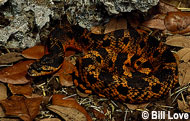Description:
Known also by the vernaculars of hissing adder and spreading adder, the eastern hognosed snake is relatively slow moving, heavy bodied, and has a large upturned rostral scale. This modified nose-tip scale helps the hog-nose unearth its favorite prey species—the toad. Eastern hognoses may be all black or colored in earthen tones with large dark dorsal blotches. The scales beneath the tail (the subcaudals) are lighter in color than the belly scales. These snakes have greatly enlarged rear teeth and mild venom but can seldom be induced to bite a human. If frightened the snake will flatten and spread its neck, strike (most often with the mouth closed), and then begin writhing spasmodically, roll upside down, and play dead, mouth open and tongue lolling in the dust. A pair of eastern hognoses may be maintained in a 30 to 50 gallon capacity terrarium. The substrate for these burrowing snakes may be of dry fallen oak and maple leaves, folded newspaper, several thicknesses of paper towels, aspen shavings or cypress shavings, or pelleted newspapers. Hiding areas in the form of small hollow logs or a plastic hide box should be provided. A water bowl sufficiently large for the snakes to both drink and soak is provided. The water must be kept fresh and clean. Daytime illumination is provided and a small undertank heater maintains a suitable temperature gradient. The temperature on the hot end of the terrarium should be about 82 degrees Fahrenheit; the cool end should be in the 70s. Nighttime temperatures can drop into the high 60s. A daytime hot spot of about 92 to 95 degrees is provided by a basking lamp. If kept merely as a pet, the hog-nosed snake may be kept warm all winter long and it will usually continue to eat. However, they may choose to miss a meal during the cooler winter months. If you intend to breed these snakes, they will probably require a 90 day period of dormancy. As mentioned, eastern hognoses prefer toads over all other prey items. It is possible to induce this snake to accept mice, but this high fat diet does not seem suitable over the long run. Hatchling hog-noses will require tiny toads. The snakes hatching usually coincides with the emergence from the ponds of the metamorphosing toads—a ready made meal. Although eastern hognoses usually have from 4 to 20 eggs, occasional clutches of more than 50 eggs have been documented. The hatchlings are from 6 to 9½ inches in length.
Habitat:
Most common on sandy soils, the eastern hognose inhabits open woodlands, pasturelands, meadows and plains.
Range:
This hog-nosed snake has an immense range. It may be found along the Atlantic seacoast from central New England to the southern tip of Florida and then westward to central Texas and central Minnesota. It also occurs in southern Ontario, Canada.
Scientific Name: Heterodon platirhinos
Species Group: hognose
Family: Xenodontidae (formerly Xenodontinae, a subfamily of the Colubridae).
Size: Males are slightly smaller. Adults may be from 18 to 45 inches in length.
Level: intermediate
Weight:
Dangerous: No


